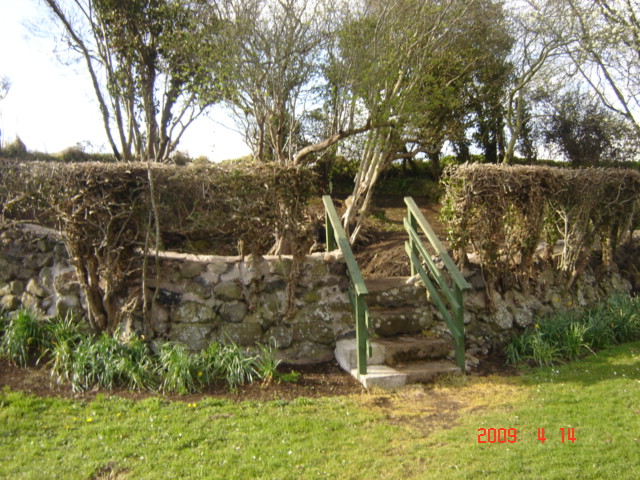St. Olcan's Well
St. Olcan's Well - Tobar beannaithe Naomh Olcán
The well at Cranfield has always been associated with St Olcan. Olcan, who was also associated with Armoy in North Antrim, lived in the same era as Saint Patrick in the 5th century AD. He is reputed to be buries in Cranfield in clay especially from Rome and his feast day is June 29th. The tradition of wells as being sacred places of worship goes back to pagan times. The druids regarded these wells along with oak groves, blackthorn trees and other places as sacred. The leaders of the early Christian church in Ireland such as Saint Patrick, St Colm Cille and St Olcan treated these traditional beliefs with respect and instead of forbidding worship at wells, they blessed them and thus began the long tradition of holy wells in Ireland where pilgrims came through the centuries to gain spiritual assistance and cures.

Customs and practices relating to the Well - Nósanna a bhaineann leis an Tobar
The Stations
Throughout Ireland there are still a limited number of places where “stations” or “patterns” are still held to the present day, one of these being Lough Derg. This is a very ancient form of devotion and was a major event at Cranfield until it died out in the first half of the 1800’s. In its hay day, the stations at Cranfield would have attracted hundreds if not thousands of pilgrims from the lough shore area of Antrim Derry and Tyrone. Fortunately we have a good description of what was involved thanks to O’Laverty’s History of Down and Connor. The practice could be carried out anytime between May Eve and St Olcan’s Feast Day on June 29th. The follwong is a paraphrasing of O’Laverty’s description:
The person performing the station collected seven ordinary small stones (not Cranfield stones) with which to count. Then, kneeling at the door of the ruined church the pilgrim said the Our Father, Hail Mary and the Creed. He then walked slowly (usually barefoot) clockwise round the church saying the Rosary. Arriving back at the door he dropped a pebble. These slow rounds of the church continued, a pebble being dropped each time the pilgrim passed the door until he had completed seven rounds. The same practice was carried out round the well seven times with a pebble being dropped each time. Upon completing this the pilgrim drew some water from the well to bathe themselves with. This procedure could be carried out on three consecutive days or all twenty one rounds of the Church and Well respectively could be carried out on the same day.
Nowadays Mass is celebrated annually at Cranfield Church and graveyard on the Sunday closest to June 29th
Cures
The traditional practice for obtaining a cure involves dipping a rag in the water of the well, rubbing the affected part of the body and finally tying the rag to the overhanging branches. As the rag decays so also will the ailment. One well known cure attributed to the power of the well took place in the early 1900’s when a woman from Newcastle on Tyne in England brought her blind son to the well and the boy subsequently regained his sight.
Cranfield Stones
The well is renowned for its small amber stones which can be obtained at any time of the year although tradition states that they are particularly abundant around June 29th each year when the well reputedly overflows on the eve of St Olcan’s feast day. These stones have always been in demand. Fishermen carried them in their boats to prevent drownings, emigrants took them with them when heading to America. They were believed to protect houses from fire and mothers in childbirth. People sewed them into their scapulas and carried them in their purses. Richard Dobbs writing in 1683 tells of a Mrs Osburn, a well to do lady living in Dublin who was cured of a “a violent flux of blood” by drinking some burnt Claret containing a Cranfield stone. The same lady had a strong belief in the efficacy of Cranfield stones close by during childbirth.

